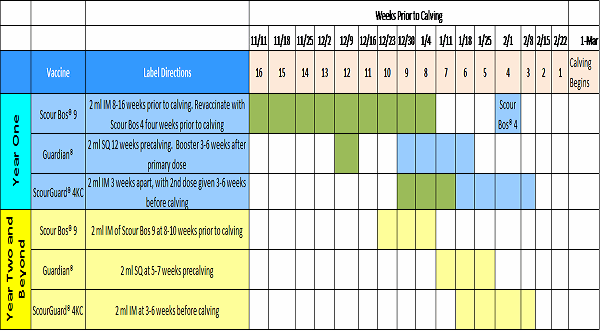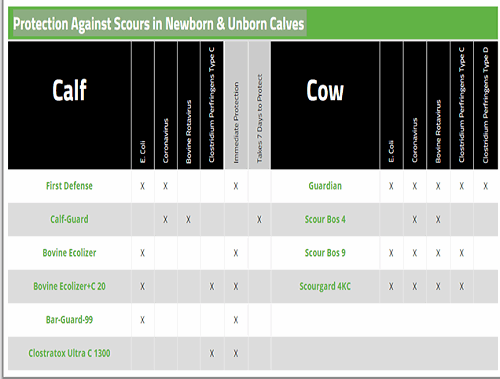By Michelle Arnold
A scours outbreak in baby calves on a cow/calf operation can be a nightmare in real life. Ask any producer who has been through this ordeal and he/she will tell you it made them want to quit the cattle business. Once the outbreak begins, it spreads quickly throughout all of the youngest calves. Bacteria, viruses and parasites can attack the lining of the calf’s intestine and cause diarrhea and dehydration. Without a healthy gut lining, essential nutrients are not absorbed from milk which leads to weakness and weight loss. During a scours outbreak, each day begins with finding and treating the sick calves, recognizing new cases that are just breaking, and sometimes having to find the remains of a calf scavenged by coyotes or buzzards. Those calves that survive may perform poorly for the remainder of their lives when compared to healthy calves. Scours vaccines are expensive yet very effective in preventing this scenario if combined with proper nutritional management of the cow during her pregnancy and a reasonable effort to keep cattle out of a filthy environment. Although there is not much one can do about rain, mud, and manure, the goal is to keep cow’s teats clean and dry to prevent the diarrhea-causing bugs from entering the calf’s mouth. Fortunately, the scours vaccine prepares the calf to deal with many of these bugs in the likely event they do make it inside the calf.
“Neonatal” calf diarrhea is defined as scours occurring within the first 3 weeks of a calf’s life. Rotavirus, coronavirus, bacteria (E. coli K99; Clostridium perfringens Type C, Salmonella spp.) and the parasite Cryptosporidia are the most common causes of neonatal calf diarrhea. Controlling rotavirus, coronavirus, Clostridium perfringens, and E. coli K99 with vaccines can significantly reduce sickness and death loss due to calf scours. Most beef cows in good body condition produce high quality colostrum but sometimes it does not contain the “correct” antibodies to fight the specific bugs that cause diarrhea. Scours vaccines are formulated to be given to pregnant cows and heifers late in gestation so they will make the correct antibodies as colostrum is being formed.
Table 1: Administration of the various scours vaccines based on calving season beginning March 1st

The 3 most popular vaccines available are ScourBos®9 and 4 (Elanco), ScourGuard®4KC (Zoetis) and Guardian® (Merck). As shown in Table 1, a first or primary dose followed by a booster dose is required the first year any scours vaccine is used (“Year One”). After the first year, just one revaccination is required (“Year Two and Beyond”) every year throughout the cow’s life. Which product you choose often depends on when you plan to work your cattle; generally, Scour Bos® is administered earlier during pregnancy, ScourGuard® is used very late in gestation and Guardian® is in-between these two options. Obviously not all calves will be born the first week of calving season but plan to give the scours vaccine based on when the first calves of the season are expected. If you have a long calving season (greater than 90 days), consider vaccinating the later calving cows closer to their due date.
It takes some planning to vaccinate correctly; timing is critically important with the different products. Using Table 1, the timing of the different vaccines would be as follows for a March 1st calving season:
1) Heifers (or cows receiving their first dose of Scours Vaccine)
If using:
- Scour Bos®9 –Administer first dose between mid-November and first of January Booster dose-Administer Scour Bos® 4 around the first of February
- Guardian®- Administer the first dose around the first week of December and the second dose during the first half of January
- ScourGuard® 4KC-Adminster first dose within the first half of January and give the second dose 3 weeks later, either towards the end of January or the first part of February.
2) Cows (Annual revaccination)
If using:
- Scour Bos®9 –Administer during the last part of December (Christmas) to first of January
- Guardian®-Administer between end of December and mid-January
- ScourGuard® 4KC-Administer between mid-January and first week of February
If the cow herd is not vaccinated and calf scours develop, there are vaccines available to administer to newborn calves. These vaccines are given by mouth as quickly as possible after birth, preferably prior to nursing and definitely within the first 12 hours of life. These will provide some immediate protection in the gut but are not nearly as effective as vaccinating the pregnant cows. As seen in Table 2, none of the products for calves protects against all 4 major pathogens ( E.coli K99, rotavirus, coronavirus and Clostridium perfringens Type C).

Table 2: A comparison of scours vaccines given to the calf at birth versus scours vaccines given to pregnant cows
Preventing calf scours involves more than jump starting the immune system of a newborn calf. Excellent cow nutrition during and after gestation, an easy calving process, and environmental management factors all contribute to a successful start. On the flip side, an inadequate quantity and/or quality of colostrum, difficulty calving, poor sanitation, cold, wet weather and overcrowding in calving areas all contribute to a higher risk of disease. Once the calf has received colostrum from the dam, it is still important to prevent the “bad bugs” (pathogens) in the environment from overwhelming the calf’s immune system. Generally, calf scour pathogens build up in the environment as the calving season progresses. Calving in the same area that older calves are in greatly increases the risk to the newborn calf, especially in wet or muddy conditions as we often see in the spring in KY. If possible, pregnant cows close to calving should be rotated onto clean pastures while cow-calf pairs remain on the old pasture. If calving in a barn or shed, the calving area should be kept as clean and dry as possible with frequent changes of bedding to remove the build-up of organisms. Make every effort to get the cow and newborn calf out of the barn quickly to lessen the chances of infection. Even the best calving management practices will have no effect if the first thing a calf ingests is manure from the calving area. Consult with your veterinarian on the best choice of vaccines for your operation.
The UK Veterinary Diagnostic Laboratory has an excellent test to diagnose the cause of calf diarrhea. A small sample of scours (in a leakproof container) from a calf that has not been treated for diarrhea with antibiotics is needed to run the test. This PCR assay tests for bovine coronavirus, rotavirus, E. coli K99, Salmonella and Cryptosporidium. The test is run on Tuesdays and Thursdays with results generally available within 2 days and costs $60 ($50 + $10 Accession Fee).
Source: osu.edu